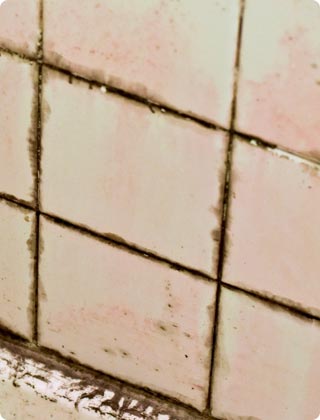Pink Mold in Bathroom Showers: Causes, Risks, and Removal

Learn how to spot pink mold, why it keeps coming back, and how to stop it for good.
If you've noticed a slimy pink film along your shower curtain, clustering in tile grout, or around your sink drain, you're not alone. It's a common bathroom problem that may look harmless but is surprisingly stubborn and often leaves people wondering how to get rid of it for good.
At O2 Mold Testing, we've seen firsthand how often pink mold gets mistaken for mildew or even more dangerous black mold. While it's technically a bacteria (not a true mold), pink mold thrives in the same humid, poorly ventilated conditions - and it loves to feed on soap scum and shampoo residue.
This guide breaks down everything you need to know: what pink mold really is, why it keeps coming back, and most importantly - how to stop it from becoming a regular problem in your bathroom. Whether you're dealing with a mild case or recurring growth, we've got you covered.
What Causes Pink Mold in Bathrooms?
Pink mold flourishes where there's moisture, residue, and little air circulation. Here's what fuels its spread:
Moisture & Humidity
Bathrooms are naturally damp environments, especially after hot showers or baths. That lingering steam creates the perfect breeding ground for bacteria like Serratia marcescens, commonly known as pink mold.
Soap & Mineral Deposits
This bacteria loves feeding on fatty residues left behind by soaps, shampoos, and conditioners. Hard water deposits also contribute to surface buildup, making it easier for pink mold to stick and grow.
Poor Ventilation
Without proper airflow, excess moisture gets trapped in the bathroom. Closed windows, weak exhaust fans, and infrequent air circulation all allow pink mold to take hold and thrive on tile, grout, curtains, and caulk.
Even with regular cleaning, the pink mold will keep returning as long as these conditions are present. That's why understanding the cause is just as important as treating the symptoms.
Is Pink Mold Dangerous?
For most people, pink mold is more of a cosmetic issue than a serious health threat. Since it's a bacteria (Serratia marcescens) and not a true mold, it doesn't produce toxic spores like black mold does. However, that doesn't mean it should be ignored.
While pink mold isn't usually harmful on contact, it can still cause problems in certain situations - especially if it enters the body through the eyes, nose, or open skin. Bathrooms, with their high humidity and frequent skin exposure, are ideal environments for that kind of accidental contact.
Who's at Risk?
- People with compromised immune systems
- Those with chronic illnesses or respiratory conditions
- Anyone with open cuts or wounds
- Young children and the elderly
In rare cases, pink mold has been linked to infections like urinary tract infections or wound infections, particularly in hospital settings. While the risk is low in your average household, it's still worth taking seriously - especially if the problem keeps coming back.
If you've cleaned repeatedly and pink mold continues to return or spread to new areas, it may be time to call in our professionals at O2 Mold Testing to rule out deeper moisture issues or hidden microbial growth.
How to Identify Pink Mold
Pink mold doesn't always look the same in every bathroom, but it tends to show up in places where moisture and residue collect. And while the name makes it sound harmless, its presence can indicate deeper moisture issues that deserve attention.
Appearance
Pink mold typically presents as a slick, slightly shiny film that ranges in color from soft pink to reddish-orange. It often starts as a faint blush in tile corners or caulking, then grows darker and more noticeable over time. You might see it clinging to shower liners, coating the grout between tiles, or forming around sink drains and toilet bases - anywhere water sits and residue builds up.
Texture
While the color can help identify it, the texture is another clue. Pink mold often feels slimy to the touch, especially when wet. In some cases, as it dries, it may take on a powdery consistency, but it rarely has the fuzziness associated with true fungal molds like black or green mold.
Smell
The odor is less intense than black mold but still unpleasant. You might notice a faint musty or damp smell in areas where pink mold is active, particularly when the bathroom has been closed up for a while. If the growth becomes extensive, the smell can become more noticeable and linger even after cleaning.
If you're unsure whether the growth in your bathroom is pink mold, mildew, or something more dangerous, professional mold testing is the smartest next step. At O2 Mold Testing, our certified inspectors use air and surface sampling to determine exactly what you're dealing with. We don't guess - we give you lab-backed results and a clear plan to move forward with confidence.
Preventing Pink Mold in the Future
Once you've removed pink mold, the real challenge is keeping it from coming back. Because pink mold is a bacterium that thrives in moist, soapy environments, prevention comes down to moisture control and consistent cleanliness.
Reduce Moisture
A well-ventilated bathroom is your first line of defense. Always run the exhaust fan during and after showers, and if your bathroom has windows, crack them open when possible. Wipe down wet surfaces like walls, tiles, and glass doors after use - a simple squeegee can make a big difference. Also, be sure to fix any leaks promptly, whether from faucets, pipes, or the toilet base, since even minor drips create the kind of damp conditions pink mold loves.
Clean Regularly
It doesn't take long for pink mold to return if residue builds up. Clean high-moisture zones at least once a week using antibacterial or mold-prevention cleaners. Pay close attention to grout lines, the base of the toilet, and shower curtains. These are the first areas where pink mold tends to reappear.
Minimize Soap Scum
Soap residue is food for bacteria. Use liquid soaps instead of bar soap, which tends to leave more scum behind. Rinse shower walls after each use, and don't forget to launder your shower curtain and liner regularly to keep buildup under control.
It's easier to prevent pink mold than to constantly scrub it away. Make these steps part of your weekly routine for a cleaner, safer bathroom - and if you suspect something more serious is hiding beneath the surface, O2 Mold Testing is here to help identify and address it before it becomes a bigger problem.
FAQs About Pink Mold
Is pink mold harmful?
Pink mold is generally not dangerous to healthy individuals but can pose a risk to those with weakened immune systems, especially through open cuts or mucous membranes. While it's not as hazardous as black mold, it still shouldn't be ignored.
How do I get rid of pink mold in my bathroom?
You can scrub pink mold away using a paste of baking soda and dish soap on affected surfaces, followed by disinfecting with a bleach-water solution (1:10 ratio). Curtains and liners can be treated with a bleach spray, then washed on a hot cycle. However, if the growth keeps coming back or spreads to hard-to-reach areas, it may be time for a professional mold inspection to uncover hidden sources.
What happens if I touch Serratia marcescens?
In most cases, nothing serious happens, but skin contact should still be avoided. The bacteria can cause minor irritation or infections if it enters wounds, the eyes, or other sensitive areas.
Why does pink mold keep coming back?
Pink mold thrives in moist, poorly ventilated spaces with leftover soap and scum. Unless those conditions change, it will keep returning no matter how often you clean.
Can pink mold grow inside walls?
Yes - if there's a plumbing leak or persistent humidity, pink mold can spread behind tiles or drywall. Professional testing can help confirm whether there's hidden growth you can't see.
Should I test for pink mold?
While pink mold itself isn't usually dangerous, it's often confused with or found alongside other types of mold. A professional inspection helps identify exactly what's growing and whether more serious remediation is needed.
When to Call a Professional
If you've cleaned thoroughly but pink mold keeps coming back, or if it starts appearing in multiple spots despite regular upkeep, it's time to get a professional involved. Persistent growth may indicate hidden moisture behind walls, faulty ventilation, or even the presence of other mold types that require specialized treatment.
You should also consider a mold inspection if anyone in your household is experiencing allergy-like symptoms, frequent respiratory irritation, or unexplained health issues. A certified mold testing team like O2 Mold Testing can perform air and surface sampling to identify what you're really dealing with - and whether the problem is bigger than it seems.
Final Thoughts
Pink mold might not be the most dangerous thing growing in your bathroom, but it's a clear sign that moisture control and hygiene routines need a second look. Regular cleaning and ventilation go a long way, but if you're dealing with a persistent or suspicious case, don't leave it to guesswork.
O2 Mold Testing offers reliable, professional mold inspection services to help you get answers - fast. Whether it's pink mold, black mold, or something else entirely, we'll help you identify the source, assess the risk, and take the next step with confidence. Your home deserves to be a healthy space, and we're here to make sure it stays that way.


